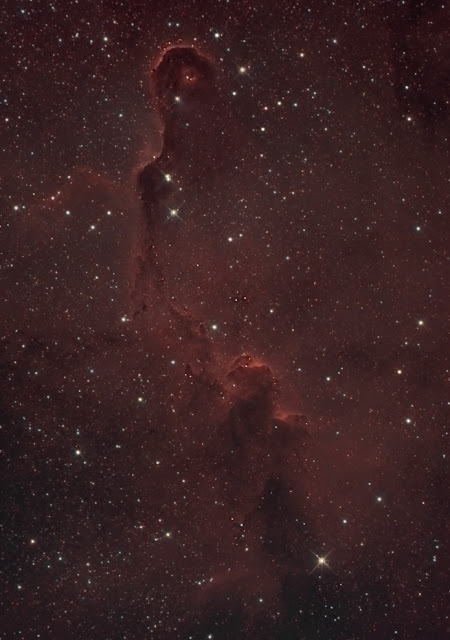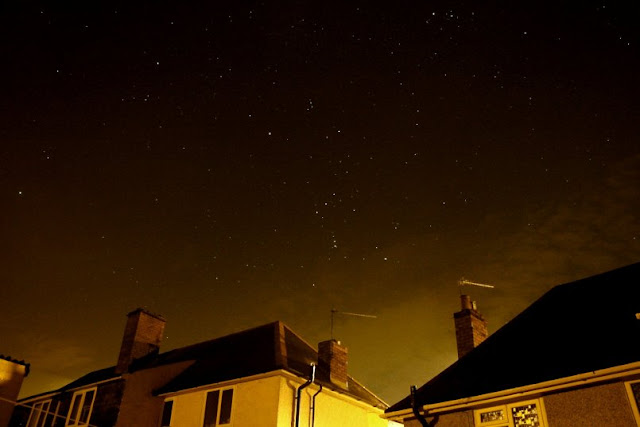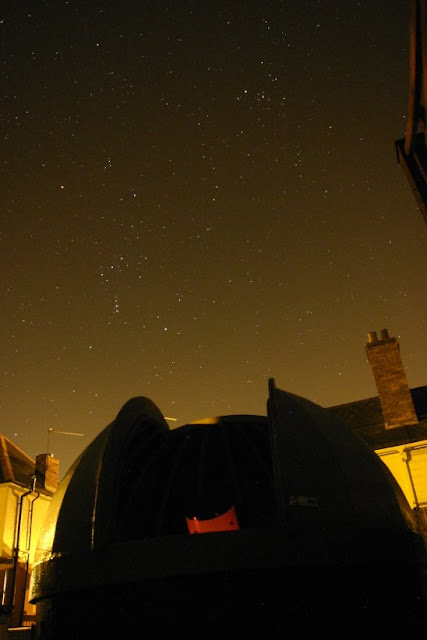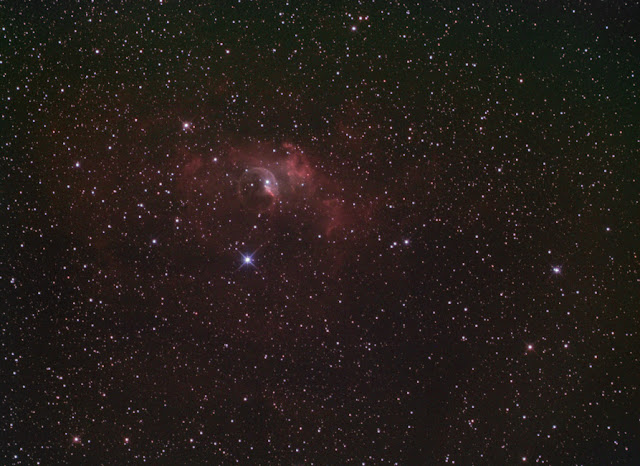Here we have an example of an advantage of using wide angle imaging. The intersecting dust lane approaching the Cocoon nebula, C19, from left to right can be easily seen in this image . The exposure times was twenty minutes using ten minute sub frames for each RGB colour filter .A two hour exposure was used using H. Alpha filter with a composition of five, ten minute and five, twenty minute subframes and matching dark frames for the image luminance:
NGC 7000 the North America and Pelican nebula. This image is a mosaic of two images stitched together using Paint Shop Pro. Tthe images were taken on two seperate evenings . A four inch refractor was used under a clear moonless sky and steady seeing conditions. The same exposure settings were used on both evnings with total exposure times of two hours in H-alpha. and twenty minutes for each RGB colour filter:
Wednesday, 31 October 2012
Tuesday, 30 October 2012
Wide field Cassiopeia
NGC7538 . M52 and NGC7635 the Bubble nebula . Cassiopeia is a wonderful region of the night sky and using a shorter focal lenght telescope reveals its glory. The exposure time was two hours in H-alpha and twenty minutes using each RGB filter . Taken using a 4 inch F7 refractor with the addition of a field flattener making it F6.3:
Here labels are given to identify the major objects in the image:
Here labels are given to identify the major objects in the image:
Monday, 29 October 2012
The Horsehead, the flame and the great Orion nebula
These images were taken through a 4" refractor. M42-43 was made from 60 min exposures with RGB filters plus 5 hours exposure with 10 min subframes in H-alpha:
This image of the Horsehead and Flame nebulae was made from 60 min exposure time through each of the RGB filters plus 3 hours of luminance with a Lumicon H-alpha filter:
This image of the Horsehead and Flame nebulae was made from 60 min exposure time through each of the RGB filters plus 3 hours of luminance with a Lumicon H-alpha filter:
Saturday, 27 October 2012
M81, M82 and the Sunflower galaxy, M63
This autoguided image of M82 was made using the f/4.8, 10" Newtonian using 25 min exposure times through each of the RGB filters plus 40 min exposure time through a Lumicon Night Sky H-alpha filter for luminance:
This autoguided image of M81 was made using the f/4.8, 10" Newtonian using 30 min exposure time through each of the RGB filters, using 5 min sub frames:
The Sunflower Galaxy, M63 was made using the f/4.8, 10" Newtonian, from 60 min total exposure time through each of the RGB filters:
This autoguided image of M81 was made using the f/4.8, 10" Newtonian using 30 min exposure time through each of the RGB filters, using 5 min sub frames:
The Sunflower Galaxy, M63 was made using the f/4.8, 10" Newtonian, from 60 min total exposure time through each of the RGB filters:
Friday, 26 October 2012
M13 and M33
This autoguided image of M33 was made from 60 minutes of dark-frame corrected, 60s exposures through each of the RGB filters with the 10", f/4.8 Newtonian.
This image of M13, the great globular cluster in Hercules was made from 20 minutes of 60s exposures through each of the RGB filters with the 10", f/4.8 Newtonian.
Thursday, 25 October 2012
NGC2244, NGC2174 The Monkey head nebula in Orion and NGC7023 the Iris nebula in Cepheus
The Monkey head nebula was made with the f/4.8. 10" Newtonian usind 20min exposures in each of the RGB filters and 40min exposures on x2 bin mode through H-alpha and Olll narrowband filters:
NGC2244 was made from 40 min exposures through Olll and H-alpha filters and a 30min exposure through a blue filter:
NGC7023, the Iris nebula was made from 50min exposures through each of the RGB filters:
Wednesday, 24 October 2012
The Pelican Nebula IC7050
This image was made from 60 min exposures with each of Olll and H-alpha narrowband filters. The imaging was done through a 10", f/4.8 Newtonian, giuded with an Orion Starshoot camera attached to a piggibacked 70mm refractor.
M51, The Whirlpool Galaxy and the Pillars of Creation
This image of M51 was made by capturing 60 min exposures in each of the RGB filters:
This image of the Eagle Nebula, M16 was made from 15 min exposures with each of the RGB filters and 60 min luminance exposure through a H-alpha narrowband filter:
This image of the Eagle Nebula, M16 was made from 15 min exposures with each of the RGB filters and 60 min luminance exposure through a H-alpha narrowband filter:
Monday, 22 October 2012
VdB 141 reflection nebula in Cepheus and the Coma Cluster
The following image of VdB 141 was made from 40 min exposures with each of the RGB filters and 90 mins with each of H-alpha and Olll narrowband filters:
The Coma Cluster
M27 in RGB and Narrowband
An Atik 383L monochrome, 8.3MP cooled camera with a Starlight Express 2" motorised filter wheel was attached to a 10" f/4.8 Newtonian. 30 min exposures were made with each of the RGB filters to produce this image:
The next image combined the data from the above image with 60 min exposures through Olll and H-alpha narrowband filters:
This image shows that the nebulosity extends much further than is generally appreciated.
The next image combined the data from the above image with 60 min exposures through Olll and H-alpha narrowband filters:
This image shows that the nebulosity extends much further than is generally appreciated.
Saturday, 20 October 2012
The Fox Fur Nebula
This image of the Fox Fur Nebula was made from 4h of exposure at x2 bin mode with a H-alpha filter for luminance and 20 min each with the RGB filters:
Monday, 15 October 2012
M104, the Sombrero Galaxy and the Elephant Trunk
This image of M104 was made from 60 min of exposure for each of the RGB filters:
This image of the Elephant Trunk Nebula was made using only Olll and H-alpha filters, 90 min exposure for each filter:
This image contains the information from the narrowband image above plus 20 min exposures with each of the RGB filters:
This image of the Elephant Trunk Nebula was made using only Olll and H-alpha filters, 90 min exposure for each filter:
This image contains the information from the narrowband image above plus 20 min exposures with each of the RGB filters:
Saturday, 13 October 2012
The Cocoon Nebula, NGC5148 and B33, the Horsehead Nebula
Exposure times were 25 min for each of the RGB filters and 3h with the H-alpha filter:
The Horsehead Nebula, B33 was made from 20 min exposures for each of the RGB filters and 2h with a Lumicon H-alpha filter:
The Horsehead Nebula, B33 was made from 20 min exposures for each of the RGB filters and 2h with a Lumicon H-alpha filter:
Saturday, 6 October 2012
Nick Hart, his equipment and his environment
Nick Hart does his astronomy from a light polluted site in Newport, South Wales.
Nick works with a variety of telescopes and cameras:
f/4.8, 10" Newtonian
Atik 383L Monochrome Cooled camera with a starlight Express 2" motorised filter wheel
Nick works in a sturdy, home made observatory dome with an adjacent shed, control room:
Nick's speciality is doing deep sky imaging from an urban, light polluted site; showing what is possible under such conditions.
The source of the light pollution:
Results from this location:
RGB image using Astronomik filtersRGB image plus colour information from an Olll and a H-alpha filter
A bi-colour image just using luminance information from the Olll and H-alpha filters.
Subscribe to:
Comments (Atom)










































